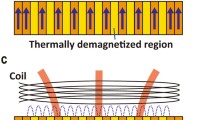Abstract
Emerging networks and applications require enormous data storage. Holographic techniques promise high-capacity storage, given resolution of a few remaining technical issues. In this paper, we propose a technique to overcome one such issue: mitigation of large magnitude peaks in the stored image that cause material saturation resulting in readout errors. We consider the use of ternary data symbols, with modulation in amplitude and phase, and use a phase mask during the encoding stage to reduce the probability of large peaks arising in the stored Fourier domain image. An appropriate mask is selected from a predefined set of pseudo-random masks by computing the Fourier transform of the raw data array as well as the data array multiplied by each mask. The data array or masked array with the lowest Fourier domain peak values is recorded. On readout, the recorded array is multiplied by the mask used during recording to recover the original data array. Simulations are presented that demonstrate the benefit of this approach, and provide insight into the appropriate number of phase masks to use in high capacity holographic data storage systems.
Similar content being viewed by others
References
P. J. van Heerden: Appl. Opt. 2 (1963) 393.
J. Ashley, M.-P. Bernal, G. W. Burr, H. Coufal, H. Guenther, J. A. Hoffnagle, C. M. Jefferson, B. Marcus, R. M. Macfarlane, R. M. Shelby, and G. T. Sincerbox: IBM J. Res. Dev. 44 (2000) 341.
B. Das, J. Joseph, and K. Singh: Opt. Commun. 282 (2009) 177.
J. F. Heanue, M. C. Bashaw, and L. Hesselink: Science 265 (1994) 749.
R. John, J. Joseph, and K. Singh: Opt. Lasers Eng. 43 (2005) 183.
J. Reményi, P. Várhegyi, L. Domján, P. Koppa, and E. Lõrincz: Appl. Opt. 42 (2003) 3428.
G. W. Burr, G. Barking, H. Coufal, J. A. Hoffnagle, C. M. Jefferson, and M. A. Neifeld: Opt. Lett. 23 (1998) 1218.
J. Joseph and D. A. Waldman: Appl. Opt. 45 (2006) 6374.
J.-S. Jang and D.-H. Shin: Opt. Lett. 26 (2001) 1797.
R. John, J. Joseph, and K. Singh: Opt. Rev. 12 (2005) 155.
S. Phillips and I. Fair: to be published in IEICE Trans. Electron.
C. B. Burckhardt: Appl. Opt. 9 (1970) 695.
J. Hong, I. McMichael, and J. Ma: Opt. Lett. 21 (1996) 1694.
M. J. O’Callaghan, J. R. McNeil, C. Walker, and M. A. Handschy: Proc. SPIE 6282 (2006) 628208.
F. Przygodda, J. Knittel, O. Malki, H. Trautner, and H. Richter: Opt. Rev. 16 (2009) 583.
Y. Saita, T. Nomura, E. Nitanai, and T. Numata: Jpn. J. Appl. Phys. 50 (2011) 09ME03.
Q. Gao and R. Kostuk: Appl. Opt. 36 (1997) 4853.
G. Berger, M. Dietz, and C. Denz: J. Opt. A 10 (2008) 115305.
Author information
Authors and Affiliations
Corresponding author
Rights and permissions
About this article
Cite this article
Phillips, S., Fair, I. Selective phase masking to reduce material saturation in holographic data storage systems. OPT REV 21, 585–590 (2014). https://doi.org/10.1007/s10043-014-0093-y
Received:
Revised:
Accepted:
Published:
Issue Date:
DOI: https://doi.org/10.1007/s10043-014-0093-y




